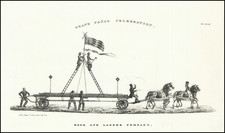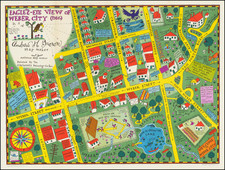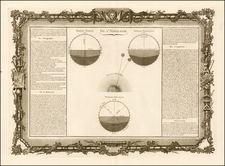"....Not a Single One Has Been Preserved" (Harvard Data Science Review)
Discovery of Only Known Example of Massive 19th-Century Hand-Colored Chronological "Mural" Chart
By an Important American Female Educational Reformer
An Enigmatically Modern Pathfinder of Data Visualization
This large and visually impressive hand-colored chart was the brainchild of Elizabeth Palmer Peabody (1804-1894), a prominent New England intellectual and figure in the Transcendentalist movement. Peabody is remembered as a pioneer of kindergarten education in America as well as for her numerous publishing projects - she edited the first version of Henry David Thoreau’s famous essay on civil disobedience (under the title Resistance to Civil Government in 1849). Her sisters Mary and Sophia were married to Horace Mann and Nathaniel Hawthorne, respectively.
Recently data visualization experts have focused on Peabody's avid promotion of a novel mnemonic system which was intended as a visual aid in learning history. The present so-called Mural Chart marks the apogee of these intriguing efforts at visual representation of historical chronology. Current academic researchers have searched in vain for an example of Peabody's Mural Charts, but none has surfaced until now. The present Christian Era chart would seem to be the only known example of its kind.
Only Known Example
The Christian Era chart is the only extant example of one of Peabody's grand "Mural Charts" - indeed recent scholarship stemming from a renewed interest in Peabody's career as a pioneer of data visualization has hightened awareness of the rarity of her mural charts. In a 2022 article published in the Harvard Data Science Review Lauren Klein wrote that historians had to speculate on the exact size and coloring of Peabody's mural charts, because "not a single one has been preserved":
An additional aspect of Peabody’s pedagogy encompassed the ‘mural charts’ that she created in order to center classroom discussion. These were large-scale versions of the charts included in her textbooks, and by all accounts they were dazzling: triangles and squares of crimson, ochre, and forest green, set against a sharp black grid. In her version of a sales pitch, Peabody would “lay [a] chart down on the floor” and invite her would-be textbook adopters to sit around it and contemplate the colors and patterns they perceived ... And yet, because the mural charts were not valued as objects of knowledge in their own time, not a single one has been preserved. Scholars even remain uncertain as to many of their basic features, including their dimensions. Peabody’s biographer, Bruce Ronda, speculates that they “must have been much larger than even folio size” (1999, p. 234). And while he does not provide any more specificity, Peabody’s nephew Julian’s recollection of the “huge, colored charts” which “hung on the walls of our sitting room” offers a first-hand account of the impression they made (Ronda, 1999, p. 227)
The Christian Era Writ Large On a Grid
The present chart attempts to display the modern era of history through a seemingly simple grid system. The 20 centuries after Christ (actually up to the year 1850) are depicted in a series of squares, with larger grid squares representing each discrete century. Our chart is an example is one of two mural charts issued to help promote the use of Peabody's system, as described in her book, The Polish-American System of Chronology, Reproduced With Some Modifications, from General Bem's Franco-Polish Method (Boston, 1850). The other chart focused on the centures before Christ.
These large Mural Charts were clearly intended for classroom use, as several cues in the form of large woodblock text indicate historical events and years that would help the student along toward internalizing the system. Thus we see indicated here in appropriate chronological position within the grid:
- Vandals (5th century)
- Sluggard Kings (6th century)
- Golden Age of Arabic Literature (late 7th century)
- Denmark and Sweden Christianized (8th century)
- Italian Republics
- Ireland
- The Cid
- Crusades
- Genghis Khan
- Helvetic Confederacy
- War of Roses
- Cortez & Pizarro
- Cromwell
- Years of War
- U.S.A.
General Bem's Franco-Polish System
Peabody adapted the so-called Polish Sytem - a grid-based mnemonic device comprising a series of ten-by-ten grids to display chonological time - after discovering it accidently through a Polish boarder named Joseph Poblielski who stayed in her family's home and shared the original charts he had brought from Poland. The system was first developed by Antoni Jazwinski and popularlized by Polish national hero General Józef Bem in the 1830s and '40s. The smallest squares in the grid represented a year, but within the squares small colored symbols stood for major historical events, such as battles, with color indicating the country of the historical event:
Bem’s system employed a grid overlaid with shapes and colors to visually represent events in time. Peabody’s version borrows the idea of a numbered grid, with each year in a century marked out in its own box. She also borrows the idea of subdividing each box, so that each of the nine interior squares corresponds to a particular type of historical event. In the Polish-American System, as in Bem’s, the top left corner is the space for wars, battles, and sieges; in the top middle is the space for conquests and unions; in the top right is the space for losses and divisions, and so on. Shapes that take up the entire box indicate an event of such magnitude or complexity that the other events in that same year hardly matter. The events are also color-coded, indicating the various countries involved. - Lauren Klein.
The overall visual effect of the chart is starkly modern - indeed, present-day observers could mistake the design for a Mondrian painting or perhaps an early punch-card computer system or video game screenshot. Daniel Rosenberg and Anthony Grafton have pointed out the modern appeal of Peabody's system in their book, Cartographies of Time: a History of the Timeline:
The incipient graphic modernism in these nineteenth-century visual approaches is expressed most clearly in the highly abstract Polish System - a ten-by-ten grid mnemonic chart filled with simple colors and lines...To an outsider, the Polish Sytem - employing chronological tables with no dates, words or images - may appear mystifying. But once learned, it isn't hard to use. First, the student needs to become familiar with the ten-by-ten grid itself, since no dates are given on the charts. To figure out when event took place, the novice student counts boxes (one box can signify a year, a decade, or a century, depending on the scale used)...Though mostly forgotten today, in its time, this system swept across Europe and North America. In the 1850s, it gained an unlikely but persuasive advocate in the American Elizabeth Palmer Peabody, an educational reformer, pioneer of the kindergarten movement, and sister-in-law to Horace Mann and Nathaniel Hawthorne.
Peabody took Bem's system to a higher level, elevating its rigid grid to an innovative visual pedagogical system that would not only help students memorize large amounts of information, but could serve as a creative memory tool. She clearly had grand ambitions for her system:
Hence the Charts, while they are intelligible to the very young, may form the basis for the highest exercises and deepest studies of the most advanced minds, and be ever recurred to, at times, to keep the memory of details fresh, as we always recur to maps. The large "Speaking Charts" will be sold separately from the manuals; but every pupil who has a manual can, after the several centuries are colored according to directions, paste them all on cloth in their proper order, in tiers of five, and thus make a chart for him or herself sufficiently large for the exercises of a group - The Polish-American System of Chronology, pages 4-5.
Color played a key part in the system as modified by Elizabeth Palmer Peabody. In comparing her system with Bem's original Peabody stated that she had "made a somewhat different, and, as it seems to me, a more expressive distribution of the colors." She even commissioned a purpose-designed paint set for students to fill in the charts, which she advertised and sold.
Peabody practiced using the large charts on her young nephew Julian, whose recollection of how his "very learned" Aunt Lizzie was indefatigable in her efforts to teach him history stands as one of the only firsthand sources of the mural charts from the pupil's perspective:
...[she attempted to teach me history] by the aid of huge, colored charts, done by my uncle Nat Peabody and hung on the walls of our sitting room... Aunt Lizzie labored during some years to teach me all the leading dates of human history - the charts being designed according to a novel and ingenious plan to fix those facts in childish memory - in Bruce A. Ronda, Elizabeth Palmer Peabody, a Reformer on Her Own Terms, page 227.
Arduous Stencil Hand-Coloring Done by Peabody Herself
Julian's comment that his uncle Nat Peabody made the large charts is interesting given Elizabeth recorded elsewhere that she herself was responsible for coloring the mural charts:
...Every school must have a mural chart - & there is but one way of making them (until they can be made by ten thousands) & that is by stencilling... I can do one a day. But I must sell them cheap... to day I worked 15 hours - only sitting down to take meals - & so I have done all week - so much fatigue stupifies one - but as soon as it is adopted in a few towns I shall be able to hire somebody to do this drudgery for me - letter by Peabody to her friends the Wards, September, 1850, cited by Ronda, page 235.
For an educator remembered today for promoting the developmental value of play, and who was strongly against rote education, it stands to reason that Peabody would adapt the Polish System into "a scheme for organizing creative thought."
Klein makes light of Peabody's expansive hopes for the Polish System, suggesting how it might lead the student to unique responses and higher levels of aesthetic and creative knowledge:
Peabody designed her charts to be abstract rather than intuitive; to promote sustained reflection rather than immediate insight. And she did so with a clear goal in mind: to provoke a unique imaginative response in each viewer. Aligning the insight-prompting power of inductive reasoning with her own ideas about the generative potential of aesthetic judgment, Peabody placed her charts within a proto-participatory learning environment that was intended to produce new knowledge about the past, as well as to help envision new pathways for the future. - Lauren Klein, "What Data Visualization Reveals: Elizabeth Palmer Peabody and the Work of Knowledge Production" HDSR (Fall 2022).
Rosenberg & Grafton have pointed out as much, noting how extant examples of the small-scale workbook charts in some library collections (e.g. the American Antiquarian Society) show that each colored chart was unique:
The Polish charts would aid such [creativity and] reading not as cheat sheets but as work sheets for thinking through and organizing ideas... The results of Peabody's appropriation of the Polish System are both handsome and surprising: surviving copies of the charts in libraries look nothing like one another. Each bears the imprint of an individual student's imagination - Rosenberg & Grafton, page 206.
It should be noted that our Mural Chart is completely separate from the small workbook examples described by Rosenberg & Grafton. The grand Mural Charts were intended for classroom instruction as well as for marketing purposes by Peabody herself. Another book by Peabody, Chronological History of the United States (1856) was illustrated with four small-scale color plates of similar-looking charts; these have been reproduced online and served to illustrate Lauren Klein's article.
A spate of recent books about Peabody (and her sisters Mary Peabody Mann and Sophia Peabody Hawthorne), has shed light on her non-traditional educational and publishing projects within the transcendentalist melieu that included Henry David Thoreau and Ralph Waldo Emerson. See, for instance: Reinventing the Peabody Sisters (Univ. of Iowa Press, 2006); Megan Marshall's The Peabody Sisters : Three Women Who Ignited American Romanticism (2006); and Bruce Ronda's Elizabeth Palmer Peabody: A Reformer on Her Own Terms (1999).
Rarity
The present example of the mural chart of the Christian Era is the only known surviving example.
We note that the Peabody's book, The Polish-American System of Chronology, is also extremely rare on the market. Going back over 100 years, RBH lists only the examples offered by MS Rare Books, which offered examples published in 1849 and 1850 in 1998 and 2011. Prior to that examples were offered by Bangs in 1877 and 1886, listing an example printed in 1852.












![Plan eines Regulairen Laagers [Plan of a Regular Camp]](https://storage.googleapis.com/raremaps/img/small/93734.jpg)


![(Tallahassee, Florida / Signed by John Quincy Adams) [Certification of full payment by John Boyd for 79 acres of land in Tallahassee, acquired from the General Land Office]](https://storage.googleapis.com/raremaps/img/small/86625.jpg)
